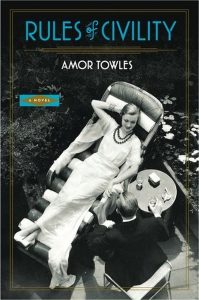Rules of Civility by Amor Towles, USA, 2011

This is a beautiful book: beautifully conceived and beautifully written. Set in New York in 1937 and 1938, it concentrates on a small group of people spearheaded by Katey Kontent, Tinker Grey and Evelyn Ross. From the moment the two working girls, Katey and Eve, meet the charming, rich Theodore (Tinker) at a jazz club, their world turns upside down, and nothing can ever be the same again.
This is a book where appearances and the rules of civility (as set down by a young George Washington) play a big part. Beginning at an art exhibition in the 1960s, where Katey and her husband are among the guests, the story suddenly reverses into the late 1930s. The catalyst for this reversal being two photos of Tinker, hanging at separate points in the exhibition.

Having traversed three decades in the batting of an eye, we are drawn into the world of two very independent, fun-loving women. Caught up in the fatalistic atmosphere of a period wedged between the Depression and the beginning of WWII, Katey and Eve are intent on having a good time, but when Tinker turns the duo into a triangle things become complicated.
Towles’ description of New York on all levels – visual, auditory and olifactory – is amazing, and although I have never actually seen the city myself (and certainly not in the 1930s), the buildings, streets, people, cars, restaurants, back alleys, upper-class hotels and flop-houses all combine to create a many-faceted and wonderful picture of that city.

The only negative comment I would make is that Katey (the ‘I’ of the book) occasionally seems more male (Towles) than female, and that, for me at least, this created some confusion in the early part of the book. However, putting this to one side, the book provokes much thought about the people we meet and the decisions we make, and how each person and each decision alters not only our path but, ultimately, who we actually are.
As Katey reminisces at the end of the book: ‘In our twenties, when there is still so much time ahead of us, time seems ample for a hundred decisions, for a hundred visions and revisions – we draw a card, and we must decide right then and there whether to keep that card and discard the next, or discard the first card and keep the second. And before we know it, the deck has been played out and the decisions we have just made will shape our lives for decades to come.’